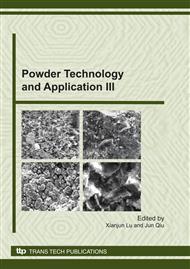p.97
p.106
p.113
p.125
p.130
p.140
p.145
p.159
p.167
Grey Relational Analysis between Particle Size Distribution of Power Storage Porous Ceramsite and Thermal Conductivity of PCM Gypsum Board
Abstract:
Phase change materials (PCMs) can be incorporated with building materials to obtain novel form-stable composite PCM which has effective energy storage performance in latent heat thermal energy storage (LHTES) systems. In this study, the PCM gypsum boards were prepared by mixing the gypsum with the power storage composite prepared by mixing with the paraffin as latent heat storage material, porous ceramsite skeleton with different particle size distribution (PSD) as adsorption matrix, and sodium alginate as reaction material. The PSD of power storage porous ceramsite were obtained by using digital camera and image process software, and the conductivity factor of PCM gypsum boards were measured by heat test machine. The directed grey relational grades between the PSD and the conductivity factor were calculated by means of grey relational rule in order to investigate the influence of PSD on the conductivity property of PCM gypsum boards. The results indicated that the porous ceramsite with size ranging from 0 to 3.0 mm could enhance the conductivity property of PCM gypsum board slightly, the porous ceramsite with size in a range from 3.0 to 14.0 mm, especially those with size range from 3.0 to 4.0 mm could obviously weaken the conductivety property of PCM gypsum board.
Info:
Periodical:
Pages:
130-139
Citation:
Online since:
November 2010
Authors:
Price:
Сopyright:
© 2011 Trans Tech Publications Ltd. All Rights Reserved
Share:
Citation:


